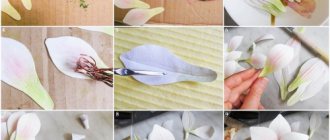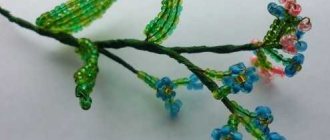How to make a paper peony with your own hands: step-by-step instructions
Attractive peonies leave few people indifferent. Do-it-yourself peonies are made from paper in different ways; there is more than one version of templates, and the sizes of flowers can vary from a standard one for a room vase to a life-size version of the peony, which is taller than a person.
For those who are just learning how to make flowers and want to try making a bouquet of paper peonies, it is better to start with a simple option and use regular colored paper.
Materials:
- Colored paper
- A thread
- Needle
- Pencil
- Wire
- Green tape/corrugated paper
On colored paper, draw simple flowers with five petals - you can draw them by hand or use a template.
The flowers should be of different sizes and a point should be placed in the center for connection.
You will need at least 10 of these flowers. Using a pencil, you need to bend all the edges of the petals. Using a needle and thread, gather all the blanks together, with the largest flowers at the bottom.
Spread the petals so that the folds point downwards. To make the trunk, wrap the wire with green crepe paper or tape.
Attach the finished paper peony to the wire.
A beautiful bouquet of peonies can be made in a slightly different way.
Materials:
- Hot gun
- Thick colored paper
- Wire
- Pencil
Flowers can be cut out according to a template or you can draw your own version.
You will need 7 templates for one flower. Use a tool to shape each petal.
The templates should curl, to varying degrees.
Insert the blanks into each other, gluing them together. Please note that the petals are staggered.
We wrap the wire with green corrugated paper or tape.
Bend the tip into a loop, passing it through the center of the sepal.
You can make large leaves from green paper and attach them to wire.
Making flowers from fabric - step-by-step photo instructions
Materials you will need:
- first of all, a workplace that is well ventilated; - candle; - matches or lighter; - chiffon or light satin (they can be purchased at fabric stores).
The fabric must be 100% polyester for you to work with it. We suggest you choose white and soft pink colors - the natural color of peonies. However, you can buy the fabric in the color you like best; - sharp tailor's scissors; - yellow macrame thread for the middle; - sewing needle with a wide eye; - a simple bobby pin, comb or hairpin - if you are making a hair accessory; - safety pin - if you are making a brooch; - Moment glue - if you are going to decorate a gift with a flower.
We proceed directly to making flowers from fabric.
Step 1 – Prepare the fabric for the flower. Cut out five squares of fabric: four with sides of approximately 10-12 centimeters, and one should be slightly smaller. Now make circles out of your squares. Don't worry if the edges of the circles are jagged - they don't have to be perfect circles.
Step 2. – Making the petals. Light a candle. Hold the edges of your petals over the flame, moving them back and forth until the edges begin to curl. Turn the fabric until all edges are curled. Be careful not to bring the fabric too close to the fire so that it starts to burn.
When working with fire, the fabric heats up - do not get burned. It is best to keep a glass of water nearby to put out the fire if necessary. Do the same with the other four petals. This process is shown in detail in the video tutorial.
Step 3. – Using scissors, cut all five of your petals into 4 equal parts, not reaching the middle (see picture).
Step 4. – On the same candle, work with the edge of the flowers. Move the edge of the petals back and forth over the fire so that its edges also bend. This time you will need both hands to work - spread the edges of the edge in different directions so that they do not stick together. Repeat this operation with all five petals. Set aside two large and one small petal.
Step 5. – Making the core of the flower. Take the remaining two petals and cut each petal into two more parts (see picture). Move the edges over the candle in the same way so that the edges curl.
Step 6 – Make a small yellow pompom from yellow embroidery floss. First, wrap the thread around your fingers several times, then make a few turns in the middle, tie and cut the thread. Remove this design from your fingers, cut the folded threads in the middle, and fluff your pompom. The photo below will help you better understand how this is done. Set the finished pom pom aside.
Step 7. – Finally, we assemble the flower: first we take two parts that have 4 petals, then we put in the parts with eight petals, the smallest part comes last. Sew a yellow pompom in the middle.
Delicate and sophisticated DIY spring peonies
you can do it using paper and corrugated paper, satin ribbons and synthetic fabric. If you have a personal plot, then be sure to plant several peony bushes on it, which will fill your house with their unsurpassed aroma in the spring. Using paper, you can create with your children, because during the summer holidays schoolchildren have a lot of free time, which can be spent on mastering new creative techniques.
Foamiran peonies: how to make them yourself
Not so long ago, a material such as foamiran burst into the world of needlework. It has become quite popular because it is not expensive, does not require additional processing, and looks bright and attractive in crafts.
Peony made from foamiran can be used to create a hairpin, brooch, hair hoop, or simply create decorative elements for the home.
This material can easily hold its shape, is not afraid of water and is safe.
Materials:
- Foamiran: pink, green
- Pastel: purple, red, green
- Wire
- Scissors
- Ruler
- Glue gun
- Wand
- Iron
We begin to prepare templates for the future flower. First, cut out squares and rectangles from cardboard according to the following dimensions:
- Part A: 4*4.5cm
- Part B: 5.3*5.5cm
- Part B: 5.5*5.5cm
- Part D: 5.5*6.5cm
From these parts we cut out petals of any shape
Transfer the template to the foamiran. We will need the following number of parts: 12 parts A, 8 parts B, 6 parts C, 18 parts D. Using pastels, color the petals: orange and purple. But we will color the details of D only with purple along the contour and display the rays.
Use an iron to finish the edges of the petals. We heat parts A and twist them into an accordion. Knead the parts with your fingers and scroll in a spiral.
To make beautiful petals B and C, first heat the ends and twist them. Then we heat the middle part of the petal and give it a bulge, while stretching it a little in width.
Petals G should be made like the previous ones, only at the end we heat the sides and twist them.
To make a peony on a stem, use a wire or stick. To do this, cut out a thin strip of 0.5 * 3-4 cm and attach it to the wire.
We attach the first petal (A) to the glue and then continue to attach parts A.
We will divide parts B into two rows of 4 parts. Glue petals B in one row.
White fabric peony
I invite beginning flower to learn a very interesting technique for making a peony from fabric using a rigid technique. We will work according to the book of the talented master Maria Chuiko. Nowadays, literally everyone is passionate about Japanese flower making techniques (me too), but I have great respect for domestic craftsmen. They are especially worthy of respect because... They carried their incredible magical skills through very difficult times, poverty and war. And the technologies that I see from the masters of the last twentieth century are not at all simple and are worthy of detailed study. So is the case with this fabric flower .
The plan is to get this decoration .
Peony from isolon: master class with step-by-step description
We have already learned how to make flowers from corrugated paper, foamiran and felt, but if you want to make decor from a more durable and strong material, then use isolon. This material was previously used for heat or sound insulation. And recently, needlewomen discovered it for themselves and began to use it in their creations. This is how beautiful peonies from isolon appeared.
To make a peony from isolon, take material no less than 3 mm thick.
Prepare petal templates. You can make them yourself or print templates.
Peony pattern templates from isolon
Using heat, give the edges a wavy shape. You need to form a ball from the scraps if you don’t have a foam ball on hand.
If the edges of the petals are sharp enough, then bend them inward.
You need to insert a rod into the base of the workpiece and then glue it with petals. To ensure they take the required shape, heat each part.
To make a beautiful shape for large petals, you will need a large round object. Place the petals on the ball and heat to give it shape.
We apply large petals to the bud and fasten it. Glue the leaves lightly so that the bud is fuller.
The largest petals do not need to be formed using a ball, but cuts can be made from the bottom to create a fold.
The last step is to glue the sepals and attach them to the stand.
Decorate the peony trunk with leaves that are located on one petiole. Make veins on the leaves using a skewer and toothpick. Glue the wire to the main part in the middle. It can be previously covered with green paper. When you wrap the main trunk with green paper, attach the wire with leaves.
Do-it-yourself peony lamp from isolon: master class
A flower made from isolon will look beautiful in the bedroom, but you can make it practical and make a peony lamp from isolon with your own hands.
The initial stage of creating a lamp is the same as when creating a decorative flower. To do this, first create a template and transfer it to the material.
You will need approximately 20 petal blanks measuring 10*10, 30 pieces 15*15 cm. Although the sizes may be different, it all depends on the desired result.
We give the petals a rounded shape using heat and a ball-shaped object. You can pull them out a little to the sides to give a wavy edge.
We begin to create the base of the bud by gluing the lampshade. The upper edges of the petals should meet at the top.
Continue gluing the petals
Let's move on to the electrical part.
Take a metal-plastic pipe 20 mm in diameter and 50 cm long.
You can decorate the pipe with heat shrink.
We make peony leaves and attach them to the stem.
Install the electrics, attaching them to the lampshade and stem. We cover the lampshade with green sepals.
To install the bud, prepare a stand, it can be a flower pot.
Pre-make holes in it for the wire, fix the stem and fill it with plaster. All that remains is to install the switch.
The top of the plaster in the stand can be decorated with sisal or decorative stones.
Large lush flowers from isolon can decorate not only a room, but also become chic decorations for any holiday.
Peony without stem
Step-by-step instructions on how to make a peony for a panel are very simple. To make it you will need simple corrugated paper (any shade of pink), cardboard, scissors and hot glue.
Prepare 12 large petals, 6 medium petals and 10 small petals. Give a convex shape to all the petals. You can use blanks from the previous master class on peonies made of corrugated paper. Make the stamens from a strip of corrugated paper cut into fringes. The basis for the flower will be a circle made of cardboard.
You need to glue the petals starting with the largest ones. There should be enough large petals for 2 rows, medium ones for one and small ones for 2.
Roll the ribbon with the stamens and glue it into the middle of the flower. The peony for the panel is ready.
Do-it-yourself peonies from satin ribbons: how to make using the kanzashi technique
Large, beautiful peonies attract attention in flower beds and flower shops. And if you want to attract attention to your image, then the ideal solution would be to make a peony from ribbons with your own hands.
For this you will need a wide satin ribbon.
Prepare the details in advance:
- 5*7 cm (6-10 pcs.)
- 4*6 cm (6-10 pcs.)
- 3*5 cm (6-10 pcs.)
- 2*4 cm (6-10 pcs.)
The splendor of the peony depends on the number of petals. In total you need from 24 to 40 parts.
We cut out the petals using the template; you can make it yourself by approximately drawing this shape.
Fire heat the edges of each petal. You can use a candle or lighter, holding each petal about 2 cm close to the fire.
It is important to ensure that the edges are not too singed.
The smallest petal needs to be rolled into a tube; you can make a few stitches at the bottom to secure it. This will be the core of the bud.
Secure the second small petal nearby. Next, continue to arrange the petals in a checkerboard pattern. When the small ones run out, take the medium ones and then the large ones.
Peonies from satin ribbons can be used to make a cute decorative bouquet for interior decoration.
We sew peonies with our own hands from fabric: different types and methods of creating a flower
To begin with, it is necessary to note that peony flowers can be very different, but, as a rule, in our minds they are associated not with ordinary, but with double forms. That is, the main feature of the flower is the presence of a huge number of petals. In addition, you can make a flower in the budding phase, half-opened and, finally, fully blossomed in all its glory.
For needlewomen who are starting to try their hand at making flowers for the first time, and especially peony, I would like to give this advice. Be sure to first carefully examine a living flower, you can even take it apart into individual petals, realize how they are folded relative to each other, how they are attached to the core. Pay attention to the shape and curvature of individual petals. You can attach them to paper and trace them - in the future, these blanks can play the role of stencils. The visual information obtained will be very useful to you in your future work, no matter what material or technique you choose.
So, a peony can be made from different types of fabric: organza, satin, tulle, silk. Consider, for example, the option of making a peony from chiffon.
First you need to prepare templates for future petals of several sizes
– you need to have at least three of them, and preferably five. To make the petals the same and to speed up the process, it is best to fold a strip of fabric eight or more times, apply a template and cut out the appropriate number of blanks. The end result should be between eight and twenty petals of each size, with the largest ones being the largest.
For beginners, the easiest option is to cut circles of different sizes from fabric.
The next step is to burn the edges of each petal or circle. To do this, you can take an ordinary candle and, holding the petal with tweezers, carefully process all the petals, simultaneously giving them the desired curvature and shape.
There are several options for assembling the flower itself. The simplest option: take a needle and thread, secure it with a blunt edge, for example, on foam plastic, and put all the petal circles on top in sequence, starting with the largest and ending with the smallest. Fasten the thread and sew several beads into the center of the flower. We got a real terry peony.
By using fabric of different shades, you can create very interesting flower options.
The petals can be connected in various other ways, by stitching and gluing them, using a center made of threads, the fabric itself or beads. The petals themselves can be cut, not forgetting to also process the edges on the candle. Using this technique, you can further increase the splendor of the produced flower.
Very beautiful peonies can be made from satin ribbons using the kanzashi technique.
At the end of the article there is a video master class on creating a peony using this technique.
DIY crepe paper peonies
A giant crepe paper peony will brighten up any occasion. This paper can be considered a universal material at hand. At first glance, it may seem that crepe paper and corrugated paper are the same thing. But there are still slight differences: crepe paper is denser and more springy, while corrugated paper is considered softer.
You can make a huge peony from thick crepe paper.
Materials:
- Paper
- Scissors
- Wire
- Pencil
- Needle and thread
- Hot glue gun
- Round form
- Newspapers
- Glue
Using a large round object, make a papier-mâché blank from newspapers and glue.
Cutting out the petals
Glue each petal to a piece of newspaper
Attach the petals in a circle, stretching them a little in the center, making a more rounded shape
Roll the edge of the petal into a tube before gluing it inside
This is what the bud will look like
The following petals can be curled inward
Gradually fill the middle of the bud
We cut out a strip of yellow paper and make a fringe along the entire length on one side. Wrap the workpiece in a roll.
Now you need to glue the petals to the outside of the workpiece. but first make holes
We attach huge petals and do it in a checkerboard pattern.
Glue the outer petals with a fold over the edge
The size of this crepe paper peony will really impress.
We make peonies from plastic mass with a description of the work
Of course, you can sculpt a peony from plasticine, but by now so many materials have been created, products from which look professional and realistic, that it is impossible to ignore them. The most convenient for creating flowers are polymer clay and cold porcelain. Polymer clay can be recommended for beginners, since it does not have the property of hardening in air, like cold porcelain. It needs to be baked in the oven or boiled to harden. In addition, it is available in many colors, mixing which you can get interesting shades. Cold porcelain is only white; when it hardens, it must be additionally painted. But it is from cold porcelain that you can make the thinnest petals and leaves that will look like real ones.
Master classes on sculpting a peony from these materials can be found at the end of the article.
Knitted and felted peonies.
Interesting flowers can be made from wool. If you already have initial felting or knitting skills, then you can quite easily create an original peony from natural materials.
Below is a brief description of the process of creating a crocheted peony. The result is a flower with a diameter of approximately 9 cm.
Cast on 6 air loops, close them in a ring and knit the 1st row in a ring - 20 double crochets. (hereinafter stsn.)
2nd row - 2 dc are knitted into each loop.
3rd row - 1 dc is knitted into each loop.
4th row – 2 dc are knitted into each loop.
You can also knit a peony using the following pattern.
Peony, in addition, can be made from various types of paper, from napkins, from beads, from plastic bottles and other materials.
How to make a peony from napkins with your own hands
Even from simple napkins you can make an original decoration with your own hands. Peonies made from napkins will be light, colorful and lush. Another positive thing is that napkins are an inexpensive material.
Such peonies can be made for a photo shoot or decorating a holiday room.
Peony with candy
Making a peony step by step with your own hands will take no more than an hour, even for an inexperienced person.
To make a flower, you need to purchase high-quality crepe paper in three colors (two shades of pink and dark green for the sepals), round candy, transparent film or mesh, and wire for the stem.
Eastern hobbies. Amigurumi. Kanzashi. Macrame. Origami
Kanzashi is an unusual hobby for women and girls, creating flowers from satin material.
The kanzashi technique will help you not only spend your time profitably, but also immerse yourself in the world of beauty and handicraft.
Try a new popular hobby, try yourself as a master of making flowers from satin ribbons, and perhaps the kanzashi technique will become your hobby for many years.
Kanzashi
From the depths of history to the present day
Japan is considered the birthplace of kanzashi. It was Japanese women who preferred artificial flowers made from ribbons. The fact is that in ancient times, in the land of the rising sun, women were not allowed to decorate their wrists or wear jewelry on their necks.
But women are an inventive people and Japanese women began to decorate their hair and hairstyles, and what women in the world can live without jewelry! The technology for making flowers from silk is about 300 years old.
It is one of the oldest and most popular handmade techniques, and is well known not only in Japan, but also in Europe.
Kanzashi masters were held in special esteem in the land of the rising sun. Both small decorations and huge bouquets were created from ribbons and rice glue.
Craftsmen made jewelry for special occasions for women from different social classes; the cost of the products was not small.
By the decoration of the hair, one could even draw a conclusion about how rich or distinguished a representative of the fair sex was from a particular family. Even in ancient times, people were greeted by their clothes!
Kanzashi master classes
Our days and the art of kanzashi
The kanzashi hobby is very popular these days. If you are an experienced needlewoman, it will not be difficult for you to master a new and popular handmade technique. Try it! Decorate wedding accessories, prom dresses, evening dresses, ball gowns with flowers. Or decorate a hairpin or hairpin using the kanzashi technique.
The products will come to life and sparkle with new colors. Pay special attention to jewelry for girls; little fairies really like artificial flowers in their hair or on dresses. You can decorate an outfit for your child's New Year's party or a prom dress for your adult daughter. Timeless and original flowers made from ribbons will be an interesting addition and will enliven any outfit.
Kanzashi
What you need to get started:
The handicraft kit is very simple and affordable; you will need something that is in every home:
- scissors,
- tweezers,
- needles,
- paraffin candle,
- soldering iron or lighter for singeing the edge of the tape.
- Iron to smooth the fabric
- threads,
- colorless glue,
- beads or buttons,
- ribbons (satin ribbons 50 mm wide) and any fabric for decoration at your discretion.
- You can also decorate flowers with rhinestones or beads. And, of course, like every master, be patient and inspired!
First steps in the kanzashi technique
To begin work, use a soldering iron to cut our tapes into equal squares. If it’s difficult for you to work with a soldering iron, you can cut the tape with scissors and simply scorch the edges over a candle fire. The edge of the fabric, singed in the fire, will not fray; we will fix the shape of our workpiece. We roll up the finished squares, giving them the shape of a leaf, and string them onto a thread.
We make a blank for the core: cut out a circle and cover it with satin, or cut out a circle from dense material. We hide the core under small decorations: beads, rhinestones, buttons, sew on lace or organza. Glue the petal blank to the core.
Then we glue it onto a comb, a hairpin, a pin, all that remains is to wait for the glue to dry and straighten the edges, giving the material the desired shape.
Kanzashi
You can make kanzashi flowers together with your children, an interesting and enjoyable activity for both you and your baby. The child will become accustomed to perseverance, aesthetic feelings and feelings of beauty will develop.
In addition, manual labor teaches children independence and patience. You can create a picture together as a gift for your mother or grandmother.
Apply ready-made flowers to canvas or cardboard, a bouquet of ribbons is an interesting gift for a woman, in addition, such a picture will delight you and your family by becoming part of an unusual decor.
To learn all the intricacies of kanzashi craftsmanship, you can look through special books on handicrafts or get acquainted with the intricacies of technology on the Internet, turn on the story about kanzashi online.
Visit exhibitions, and maybe over time, your works will be presented here. After all, inspiration, skill and beauty always find many like-minded people and fans.
Besides the fact that this type of handicraft is very popular as a hobby, it can also be a good idea for business development.
You can sell your work in stores specializing in the sale and production of wedding accessories, online stores, home decor stores, and even just among acquaintances and friends. Unfading satin kanzashi flowers are an interesting hobby, unusual decor and, of course, a good mood.
Kanzashi master classes
Source: https://easternhobby.ru/yaponiya/kanzashi











